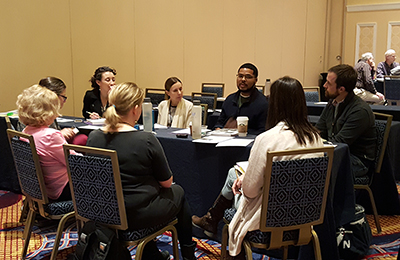
Notes related to specific questions discussed are presented below. CBI participants discussed tw questions: what aspects of your curriculum might present accessibility challenges and what resources or tools would be helpful to you or to teachers in order to be prepared for students with disabilities in their courses.
What aspects of your curriculum might present accessibility challenges?
- Some programming languages are inaccessible to individuals who have mobility or sensory impairments. Others may be challenging for students with learning disabilities.
- For some students, particularly those with learning disabilities, animations and complex images can be more accessible than volumes of words. However, these images are inaccessible to students who are visually impaired unless they are described well. In addition, audio must be captioned or transcribed for students with hearing impairments.
- Student-facing materials are not always designed to be accessible to students with disabilities.
- Tools can affect pedagogy; classrooms can be more flexible with cloud storage protocols, a version tool for formative assessment, and a programming language that is a block language. Each of these things could present accessibility challenges.
- The physical space in a computer science classroom can be challenging for students with disabilities that affect sight and mobility.
- Free online resources and tutorials should be made accessible, since a lot of teachers rely on these resources. Many integrated development environments (IDEs) are inaccessible. However, many programmers don’t use IDEs at all; many just use a text editor. While a student with a visual impairment can use a screen reader’s verbose mode, its use can be very frustrating.
What resources or tools would be helpful to you or to teachers in order to be prepared for students with disabilities in their courses?
- Videos for recruiting students with disabilities into computing courses and videos that showcase accessible technology, including demonstrations of people with different disabilities using the technology. Resources related to new accessible technology as it becomes available, since computer science teachers need to learn about it, but often these resources are not on their radar.
- Resources about how Quorum or other accessible technologies can be used in Computer Science Principles classes to ensure the curriculum is accessible.
- Resources targeted towards teachers for working with students with disabilities.
- Voice-controlled programming languages that can be used without a keyboard and mouse.
- Strategies for identifying students with disabilities who could be successful in computing courses but might not seek out computing courses on their own.
- Profiles of computing students and professionals with disabilities sharing their stories to inspire and motivate other students and give teachers examples of how students can be successful.
- A unit to be used in professional development of teachers about students with disabilities in computing courses that covers accessibility and universal design. This would include tools and resources that those teachers could then use in the classroom.
- Resources about accessibility in relation to the most popular programming CSP instructional materials, including AppLab, SNAP!, and Scratch.
- Accommodations and universal design practices for pair work, journaling, and tasks that will be on the Advanced Placement exam.
- A list of most accessible Java IDEs so computer science teachers can be encouraged to choose a better IDE, along with instructions for how to use a text editor to edit, compile, and run programs.
- Specific resources for learning disabilities, including something with vocabulary and key context for students to refer to.
- Quick reference guides for accessible programming tools, CSP and Accessibility challenges, and ECS and CSP resources.
- A guide that addresses how teachers can implement accommodations with disabilities and how sometimes their use can benefit the class as a whole.